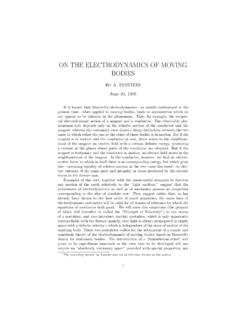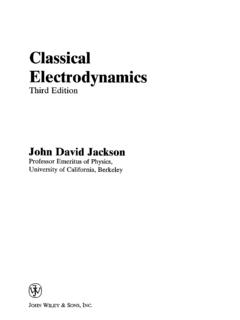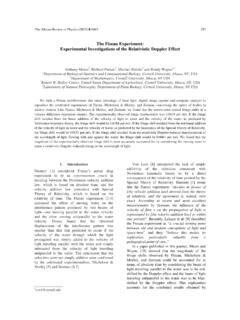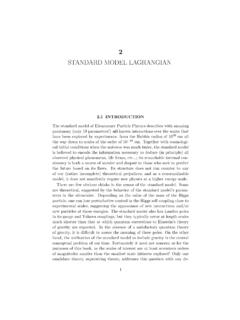Transcription of Mechanics Lecture Notes
1 Mechanics Lecture Notes1 Lecture 1: Statics equilibrium of a IntroductionThis Lecture deals with forces acting on a particle which does not move, is inequilibrium. Theimportant concept is the resolution of forces to obtain the equations determining equilibrium. It isessential when solving such problems to start with a good diagram showing all the example introduces the idea of friction which, although simple at first sight, turns out tobe quite subtle. The idea of limiting friction is introduced: this occurs when something is just onthe point of Key concepts Reduction of a number of forces to oneresultantforce by vector addition. Condition for equilibrium: the resultant force is zero. Resolution of forces in orthogonal directions to determine an unkown force. Frictional force;limiting frictionand relation via thecoefficient of frictionto the ForcesWe consider here the the situation of a stationary particle acted on by a number of forces.
2 Itis not very useful to attempt to define exactly what we mean by aforce: examples of forces we can think of a force as something that tends to produce motion. A force is thereforeobviously a vector are (as far as is known at present) four fundamental forces: gravity, electromagnetism,weak nuclear force and strong nuclear force. Each force is accompanied by a theory and a set ofequations governing the behaviour of the force and objects affected by the other forces are derived from these forces. Examples in no particular order are friction,tension in strings, normal reaction forces, air resistance, viscosity, magnetism, gravity, van derWaals forces between molecules, etc. I m sure that you can think of many more example, for a particle on a rough horizontal table being pulled by a string (though nothard enough to make the particle move), the forces are as shown in the diagram.
3 There are twoexternal forces, namely the applied (pulling) force acting along the string, and the weight actingdownwards. The table exerts two forces on the particle: one is the force of friction which tends tooppose motion; the other is the reaction of the table on the particle that stops the particle fallingthrough the table. This latter force is normal to the surface of the table and is called reactionFrictionWeightApplied force 1It is tempting to use Newton s second law to define force, but there is a danger of a circular accepted theories are General Relativity, Quantum electrodynamics, Electroweak, and Quantum Chro-modynamics, respectively. Other theories, such as string theory, attempt to combine these EquilibriumA particle or body is said to bein equilibriumwhen all the forces acting on it balance and it is notin motion.
4 Algebraically, this just means that the vector sum of the forces is zero: iFi=0or, equivalently, the components of the vectors in three directions (which must be linearly indepen-dent, of course, but not necessarily orthogonal) sum to , this means that the vectors representing the forces (in both direction andmagnitude) can be joined to form a closed order to determine whether a particle is in equilibrium (or, given that it is in equilibrium,to determine an unkown force) we have to check that the vector sum of the forces, theresultantforce, is zero. That means that the resultant force should have no non-zero component in anydirection. Normally, the way to check this is to check the components of the resultant force in threeindependent directions, which need not be orthogonal but are usually, for convenience, process is calledresolving forces.
5 It can best be understood in a concrete particle of weight3 Wlies on a fixed rough plane inclined at angle to the horizontal. It is heldin position by a force of magnitudeTacting up the line of greatest slope of the plane. Find thefrictional force,F, in terms ofW, anything else, we must draw a good diagram showing all the forces. The importanceof a diagram is seen immediately: as soon as we try to draw in the frictional forceFwe realise thatwe don t know which way it acts up or down the was stated earlier, the frictional force opposes the motion, so if, in the absence of friction,the forceTis large enough to pull the particle up the plane, friction acts down the plane. If, in theabsence if friction, the weight is enough to pull the particle down the plane, then friction acts upthe plane.
6 We assume first the former: friction acts down the weight of the particle is the magnitude of the force it experiences due to gravity; for a particle of massm,W=mg, wheregis the (constant) acceleration due to FW The strategy for all similar problems is to determine the equations of equilibrium by resolving( taking components of the vectors) forces in two directions and equating to zero. It helps tochoose the directions carefully in order to reduce the number of terms in each , for our problem, it is a good plan to resolve parallel and perpendicular to the have, respectively:T=F+Wsin (1)R=Wcos (2)ThusF=T Wsin , using only the first , we are interesting in finding the value ofTthat will support the particle on theplane. To accomplish this, we have to know something about the frictional force.
7 The experimentalresult relating the frictional force to the normal reactionF R(3)is generally used. Here is thecoefficient of friction, the value of which depends on the surfacesinvolved4. When the equality holds, the friction is said to our example, combining equations (1) and (2) with the experimental law (3) givesT W(sin + cos ).Note that in the case of limiting friction,Tis determined by this , instead of assuming that the particle is tending to slip up the plane, we assume that it istending to slip down the plane, then the frictional force would act up the plane. In this case (checkthis!) we findT W(sin cos )and combining the two results gives the range of values ofTfor which equilibrium is possible, fora given value of :W(sin cos ) T W(sin + cos ).Not surprisingly, in order for the particle to remain in equilibrium not move Tcannot betoo big or too that ifTwere given (for example, if it were the tension in a string that passes over apulley and has a weight dangling on the other end) the above equation would give bounds on thevalues of allowed for most common materials, the coefficient of friction lies between and , though it can be considerablyhigher: for silicone rubber on tarmac it is over 1 (which is a good thing).
8 3 Mechanics Lecture Notes1 Notes for lectures 2 and 3: Equilibrium of a solid IntroductionThis Lecture deals with forces acting on a body at rest. The difference between the particle of thelast Lecture and the body in this Lecture is that all the forces on the particle act through the samepoint, which is not the case for forces on an extended body. The important concept, again, is theresolution of forces to obtain the equations determining simplest examples involve essentially one-dimensional bodies such as ladders. Again, itis essential start with a good diagram showing all the Key concepts Resolution of forces into a singleresultant forceor acouple. Themomentof a force about a fixed point. Condition for equilibrium: zero resultant force and zero total Resolving forcesThe difference between forces acting on a particle and forces acting on an extended body is imme-diately obvious from the intuitive inequivalence of the two situations below: for an extended body,it matters through which points the forces act on the position of theline of actionof In general, each force acting on a body can be thought of as having two effects: a tendencyto translate the body in the direction parallel to the line of action of the force; and a tendency torotate the , for the body to be in equilibrium these effects must separately the translational effects to balance, we need (as in the case of a particle) the vector sumof the forces to be zero: iFi= 0.
9 (1)For the rotational effects about a pointPto balance, we need the sum of the effects to bezero, but what does this mean? Intuitively, we expect that a force whose line of action is a longway fromPto have more rotating effect than a force of the same magnitude that is nearer and itturns out (see below) that the effect is linear in distance. The rotation effect of a force is called themomentof the The moment of a forceIn two dimensions, or in three dimensions in the case of a planar body and forces acting in the sameplane as the body, any force tends to rotate the body within the plane or, in other words, about anaxis perpendicular to the plane. In this case, we define:Moment of a force about a pointP=magnitude of the force the shortest distance between the line of action of the force that one point, not on the line of action of the force, is account taken of the direction of the effect: either clockwise or general (in three dimensions when the body and forces are not coplanar), the effect ofdifferent forces will be to tend to rotate the body about different axes.
10 In this case, the force timesdistance from line of action to the point definition of the moment of a force is not adequate. Wehave to represent the moment as a vector. The important thing to understand is that the directionof vector representing the moment of the forcenotin the direction in which the body might move;it is along an axis about which the body might can obtain the required vector expression for the moment of a force from a diagram. Inthe diagram below, the magnitude of the moment of the forceFabout the pointPis|F| mentioned above, the moment of a force is a vector quantity, the direction of the vectorbeing parallel to the axis throughPabout which the body would rotate under the action of theforce. This can be very conveniently expressed using the vector cross product:moment ofFaboutP=r F(2)whereris the position vector fromPto any point on the line of action is this cross product the right expression for the moment?






